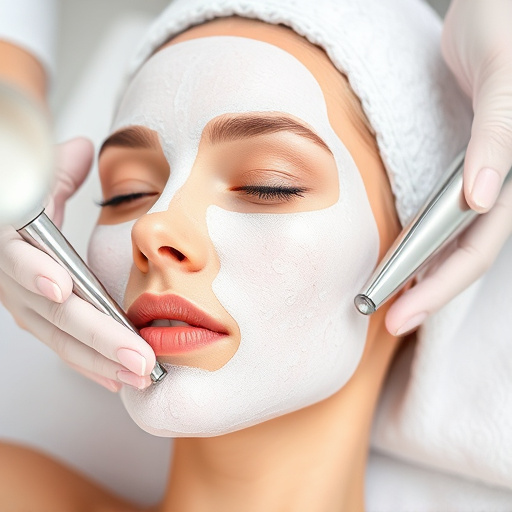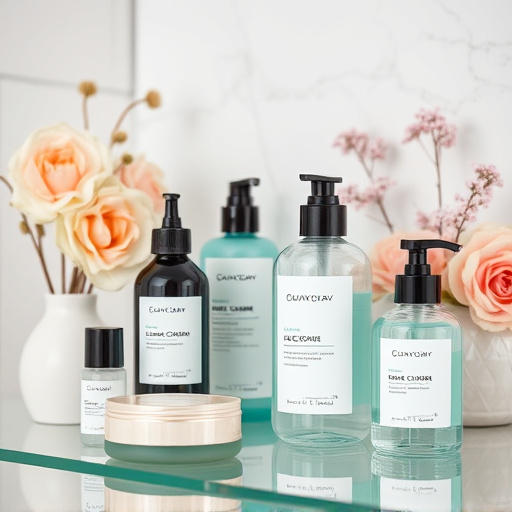Stretch Mark Treatment: Enhance Moisturize for Flawless Skin
Stretch marks, caused by rapid growth or weight changes, can be improved with proper moisturizing ro…….
Stretch marks, also known as striae, are a common skin condition that occurs when the dermis (the skin’s underlying layer) is stretched rapidly beyond its elastic limits. This phenomenon is often associated with rapid weight gain or loss, pregnancy, puberty, and other periods of rapid growth or physical changes. While stretch marks can be cosmetically concerning for many individuals, they are generally harmless and a natural part of the body’s response to stretching. The quest for effective stretch mark treatment has led to a diverse range of approaches, from topical creams to medical procedures. This article aims to provide an in-depth exploration of stretch mark treatment, covering its history, current practices, global impact, technological innovations, regulatory landscape, and future prospects.
Definition: Stretch mark treatment refers to a range of interventions designed to minimize the appearance of existing stretch marks or prevent their formation. These treatments aim to improve skin elasticity, reduce scarring, and restore a more youthful and smooth skin texture.
Core Components: The primary focus of stretch mark treatment is on two key areas:
Skin Care and Moisturization: Maintaining optimal skin hydration is crucial as dry skin is more prone to developing stretch marks. Topical products containing humectants (moisturizers) can help prevent and reduce the depth of existing stretch marks.
Elasticity Enhancement: Treating stretch marks involves stimulating collagen and elastin production, which are essential proteins for maintaining skin elasticity. This can be achieved through various means such as topical creams, retinoids, microdermabrasion, or laser therapy.
Historical Context: The treatment of stretch marks has evolved over centuries, reflecting advancements in medical knowledge and cosmetic science. Ancient civilizations like Egypt and Greece used natural remedies to address skin concerns. In modern times, the development of scientific understanding led to more targeted treatments, including the discovery of retinoids (vitamin A derivatives) for collagen stimulation.
Significance: Stretch mark treatment is significant for several reasons:
The global stretch mark treatment market is influenced by a range of factors, including cultural beauty standards, lifestyle trends, and healthcare accessibility.
| Region | Market Dynamics | Key Trends |
|---|---|---|
| North America | High disposable income, advanced medical infrastructure | Growing demand for non-invasive procedures, focus on natural ingredients |
| Europe | Strict cosmetic regulations, emphasis on safety and efficacy | Increasing adoption of laser treatments, rise in men seeking treatment |
| Asia Pacific | Rapidly growing economy, changing beauty ideals | Preference for at-home treatments, integration of traditional medicine |
| Latin America | Rising healthcare expenditure, awareness campaigns | Growing market for over-the-counter products, increasing popularity of social media influencers |
Regional Disparities: The availability and accessibility of stretch mark treatment vary significantly across regions due to economic disparities, healthcare infrastructure differences, and cultural attitudes towards beauty. Developed countries often offer a wider range of advanced treatments, while developing nations may focus more on affordable, accessible options.
The stretch mark treatment market operates within a complex economic ecosystem, influenced by factors such as:
Market Size: The global market is projected to reach USD 12.8 billion by 2027, growing at a CAGR of 6.5% from 2020 to 2027 (Source: Grand View Research). This growth is driven by increasing consumer awareness and changing beauty standards.
Investment Patterns: The industry attracts significant investment from both pharmaceutical companies and startup innovators. Many startups focus on developing novel formulations or delivering existing treatments in new, innovative ways.
Economic Impact: Stretch mark treatment contributes to economic growth through product sales, medical procedures, and related services. It also reflects the broader trend of consumers investing in personal care and wellness.
Technological innovations have played a pivotal role in enhancing stretch mark treatment options:
Laser Therapy: Fractional laser technology has revolutionized stretch mark treatment by stimulating collagen production and improving skin texture. Different laser types, such as Nd:YAG and Erbium, are used to target specific depths of the dermis, promoting skin renewal.
Microdermabrasion: This procedure uses a special applicator with an abrasive surface to gently sand away the top layer of damaged skin, revealing smoother, more elastic skin beneath.
Topical Creams and Ointments: Advancements in formulation science have led to the development of creams containing active ingredients like retinol, shea butter, and peptides, which can improve skin elasticity and reduce the appearance of stretch marks.
At-Home Devices: Over-the-counter (OTC) devices, such as roller-based systems and ultrasound devices, are gaining popularity for their convenience and affordability. These tools aim to mimic professional treatments at home.
The regulatory landscape surrounding stretch mark treatment varies across jurisdictions:
North America: The US Food and Drug Administration (FDA) regulates cosmetic products, including those marketed for stretch mark treatment. Product safety and efficacy claims must be supported by substantial evidence.
Europe: The European Union’s Cosmetics Regulation sets strict standards for product safety and labeling. Ingredients used in stretch mark treatments are rigorously evaluated to ensure their security and effectiveness.
International Standards: Organizations like the International Organization for Standardization (ISO) develop guidelines for cosmetic procedures, ensuring consistent quality and safety practices globally.
Despite significant advancements, stretch mark treatment faces several challenges and criticisms:
Lack of Universal Effectiveness: Different treatments work variably for individuals due to genetic differences, skin type, and the severity of stretch marks. What works for one person may not be effective for another.
High Costs: Many advanced treatments, particularly non-invasive procedures like laser therapy, can be expensive, limiting accessibility for individuals with financial constraints.
Side Effects: Some treatments carry potential side effects, such as skin irritation, redness, or post-inflammatory hyperpigmentation. Proper patient selection and consultation are crucial to mitigate these risks.
Strategies to Overcome Challenges:
Case Study 1: Laser Therapy for Post-Pregnancy Stretch Marks
A 32-year-old woman sought treatment for stretch marks on her abdomen after two pregnancies within a year. She underwent fractional Nd:YAG laser therapy, a non-invasive procedure combining heat and light energy to stimulate collagen production. After a series of sessions, she noticed significant improvements in skin texture and the appearance of her stretch marks, achieving a more even skin tone.
Key Takeaways:
Case Study 2: Topical Cream for Teenagers with Acne-Related Stretch Marks
A 17-year-old teenager consulted a dermatologist regarding stretch marks on her upper arms, caused by rapid weight gain and acne. The dermatologist recommended a combination of treatments, including a prescription retinoid cream and microdermabrasion. After several months, the teenager noticed improved skin elasticity and reduced scarring, leading to more even skin tone.
Lessons Learned:
The future of stretch mark treatment looks promising, with several emerging trends and growth areas:
Personalized Medicine: The rise of genomics and precision medicine will enable more tailored treatment approaches, considering an individual’s genetic makeup and response to different therapies.
Digital Health Solutions: Mobile apps and telemedicine platforms can provide educational resources, personalized recommendations, and remote monitoring for stretch mark treatment, making care more accessible.
Natural and Plant-Based Ingredients: There is a growing demand for topical products with natural origins, offering potential benefits for both stretch mark prevention and treatment.
Non-Invasive Technologies: Innovations in ultrasound, radiofrequency, and other non-invasive technologies will continue to shape the market, providing safe and effective alternatives to surgical procedures.
Stretch mark treatment represents a dynamic and evolving field within the broader dermatology and cosmetic industry. The diverse range of treatments available today reflects the intricate interplay between science, technology, and consumer needs. As the global market continues to grow, driven by changing beauty standards and increasing disposable incomes, the future holds exciting possibilities for improving stretch mark management.
Q: Are stretch marks harmful?
A: While unsightly, stretch marks are generally harmless. They result from rapid skin stretching and do not indicate any health issues. However, severe or unusual stretch marks might be associated with underlying medical conditions, requiring medical evaluation.
Q: How can I prevent stretch marks during pregnancy?
A: Maintaining a healthy weight gain during pregnancy, using specialized prenatal creams, and practicing good skin care routines can help minimize the risk of developing stretch marks. Regular exercise and a balanced diet are also beneficial.
Q: Are there any home remedies for stretch marks?
A: While some natural remedies like coconut oil and aloe vera have shown modest benefits, scientific evidence supporting their effectiveness is limited. Topical treatments containing retinol or vitamin C may offer better results for some individuals.
Q: How effective are laser treatments for stretch marks?
A: Laser therapy, particularly fractional laser procedures, has demonstrated significant improvements in stretch mark appearance and skin texture. However, multiple sessions are typically required, and results can vary based on individual factors.
Q: Is microdermabrasion painful?
A: Microdermabrasion is generally well-tolerated, but it may cause temporary redness and sensitivity. Modern techniques use less aggressive methods, minimizing discomfort. It’s crucial to consult a qualified professional for the best experience.

Stretch marks, caused by rapid growth or weight changes, can be improved with proper moisturizing ro…….

Looking for a natural stretch mark treatment? This comprehensive guide explores effective ways to re…….